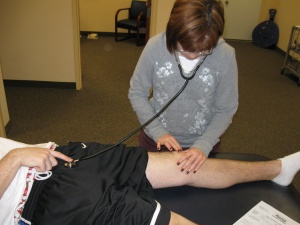Patellar-Pubic Percussion Test: Difference between revisions
No edit summary |
Kim Jackson (talk | contribs) (corrected reference error) |
||
| (34 intermediate revisions by 11 users not shown) | |||
| Line 1: | Line 1: | ||
{{ | <div class="editorbox"> | ||
'''Original Editor '''- [[User:Michael Conaway|Michael Conaway]] | |||
'''Top Contributors''' - {{Special:Contributors/{{FULLPAGENAME}}}} | |||
</div> | |||
== Purpose == | |||
To identify occult hip fractures. | |||
[[Image:Patellar-pubic percussion test.JPG|300px|Photo: Mike Conaway]] | |||
<br> | |||
== Technique == | |||
The Patellar-Pubic Percussion Test is a form of Osteophony or auscultatory percussion which is used in the assessment of bone integrity by analyzing its vibrations through the use of a stethoscope and bony prominence percussion.<ref name="Borgerding et al">Borgerding LJ, Kikillus PJ, Boissonnault WG. Use of the Patellar-Pubic Percussion Test in the Diagnosis and Management of a Patient with a Non-Displaced Hip Fracture. J Manual and Manipulative Therapy.2007;15:E78-E84.</ref> | |||
{{#ev:youtube|bZccYojlDvQ|400}} <ref>BJSM Videos. Patellar pubic percussion test, with Mike Reiman. Available from: http://www.youtube.com/watch?v=bZccYojlDvQ [last accessed 25/01/14]</ref> | |||
== Sensitivity/Specificity == | |||
Tiru et al<ref name="Tiru et al">Tiru M, Goh SH, Low BY. Use of percussion as a screening tool in the diagnosis of occult hip fractures. Singapore Med J 2002;43:467-469.</ref> found a sensitivity of .96 and a specificity of .86 for the PPPT in the diagnosis of femoral neck fractures. | |||
== Evidence == | |||
In the United States hip fractures have a yearly incidence of about 300,000. This number is expected to double or possibly triple by the year 2040. Morbidity and mortality are reported to be as high as 14-36% in the first year after injury.<ref name="Perron et al">Perron AD, Miller MD, Brady WJ. Orthopedic Pitfalls in the ED: Radiographically occult hip fracture. Am J Emerg Med 2002;20:234-237.</ref><ref name="Brunner et al">Brunner LC, Eshilian-Oates L, Duo TY. Hip Fractures in adults.Am Fam Phys 2003;68:537-542.</ref> In 2-10% of those patients that present to the ER with a painful hip after trauma, initial radiographs will not show the occult fracture.<ref name="Lubovsky et al">Lubovsky O, Liebergall M, Mattan Y, Weil Y, Moshieff R. Early diagnosis of occult hip fractures: MRI versus CT scan. Injury Int J Care Injured 2005;36:788-792.</ref> Adams et al<ref name="Adams et al">Adams SL, Yarnold PR. Clinical use of the patellar pubic percussion sign in hip trauma. Am J Emerg Med 1997;15:173-175.</ref> reported an interrater agreement of 90.2% for the PPPT. | |||
== References == | |||
<references /> | |||
[[Category:Assessment]] | |||
[[Category:EIM_Residency_Project]] | |||
[[Category:Hip]] | |||
[[Category:Musculoskeletal/Orthopaedics]] | |||
[[Category:Special_Tests]] | |||
[[Category:Primary Contact]] | |||
[[Category:Hip - Assessment and Examination]] | |||
[[Category:Hip - Special Tests]] | |||
Latest revision as of 00:47, 3 May 2021
Original Editor - Michael Conaway
Top Contributors - Admin, Michael Conaway, Kim Jackson, Laura Ritchie, Fasuba Ayobami, WikiSysop, Claire Knott, 127.0.0.1, Tony Lowe, Evan Thomas and Kai A. Sigel
Purpose[edit | edit source]
To identify occult hip fractures.
Technique[edit | edit source]
The Patellar-Pubic Percussion Test is a form of Osteophony or auscultatory percussion which is used in the assessment of bone integrity by analyzing its vibrations through the use of a stethoscope and bony prominence percussion.[1]
Sensitivity/Specificity[edit | edit source]
Tiru et al[3] found a sensitivity of .96 and a specificity of .86 for the PPPT in the diagnosis of femoral neck fractures.
Evidence[edit | edit source]
In the United States hip fractures have a yearly incidence of about 300,000. This number is expected to double or possibly triple by the year 2040. Morbidity and mortality are reported to be as high as 14-36% in the first year after injury.[4][5] In 2-10% of those patients that present to the ER with a painful hip after trauma, initial radiographs will not show the occult fracture.[6] Adams et al[7] reported an interrater agreement of 90.2% for the PPPT.
References[edit | edit source]
- ↑ Borgerding LJ, Kikillus PJ, Boissonnault WG. Use of the Patellar-Pubic Percussion Test in the Diagnosis and Management of a Patient with a Non-Displaced Hip Fracture. J Manual and Manipulative Therapy.2007;15:E78-E84.
- ↑ BJSM Videos. Patellar pubic percussion test, with Mike Reiman. Available from: http://www.youtube.com/watch?v=bZccYojlDvQ [last accessed 25/01/14]
- ↑ Tiru M, Goh SH, Low BY. Use of percussion as a screening tool in the diagnosis of occult hip fractures. Singapore Med J 2002;43:467-469.
- ↑ Perron AD, Miller MD, Brady WJ. Orthopedic Pitfalls in the ED: Radiographically occult hip fracture. Am J Emerg Med 2002;20:234-237.
- ↑ Brunner LC, Eshilian-Oates L, Duo TY. Hip Fractures in adults.Am Fam Phys 2003;68:537-542.
- ↑ Lubovsky O, Liebergall M, Mattan Y, Weil Y, Moshieff R. Early diagnosis of occult hip fractures: MRI versus CT scan. Injury Int J Care Injured 2005;36:788-792.
- ↑ Adams SL, Yarnold PR. Clinical use of the patellar pubic percussion sign in hip trauma. Am J Emerg Med 1997;15:173-175.







